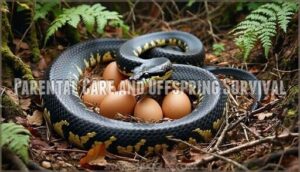This site is supported by our readers. We may earn a commission, at no cost to you, if you purchase through links.

When the crowd gathers, mating balls form, with dozens of males writhing around a single female. If you think snakes are loners, think again—females often mate with several males, boosting their babies’ survival odds. There’s even more drama and strategy hidden in these slithery love stories. Females often mate with several males, is part of females play it cool concept but for clarity it was left as is.
Table Of Contents
- Key Takeaways
- Types of Snake Mating Rituals
- Seasonal Timing of Snake Mating
- Courtship Behaviors and Displays
- Reproductive Anatomy and Copulation
- Unique and Species-Specific Mating Phenomena
- Frequently Asked Questions (FAQs)
- What are Snake mating rituals?
- How do snakes mate?
- What are snake courtship rituals?
- What do snakes do during mating season?
- How do female snakes behave after mating?
- Why does a female snake have a plug after mating?
- What does it look like when snakes are mating?
- Do snakes dance when mating?
- Why do snakes intertwine with each other?
- How to tell if snakes are fighting or mating?
- Conclusion
Key Takeaways
- You’ll see male snakes wrestling and forming tangled mating balls to compete for a female’s attention.
- Females leave pheromone trails for males to track, and often mate with several partners to boost their offspring’s survival odds.
- Snake mating rituals range from fierce territorial combat to subtle scent-based attraction, with some species even reproducing without males.
- Mating can last hours, involves precise body alignment, and females often store sperm for future fertilization.
Types of Snake Mating Rituals
You’ll find snake mating strategies as diverse as the species themselves, ranging from intense territorial battles to peaceful encounters.
These rituals have evolved over millions of years, creating fascinating displays that guarantee successful reproduction while maximizing each snake’s chances of passing on their genes.
These rituals have become an essential part of the snakes’ behavior, ensuring the continuation of their species.
Territorial Combat
Dominance drives everything in snake territorial combat. When multiple males compete for a female’s attention, the wrestling match begins—literally.
You’ll witness nature’s version of heavyweight boxing as these serpents engage in ritualized battles that determine mating rights. Larger males often participate in grass snake mating balls to compete for a female.
Epic wrestling matches decide which snake wins the right to mate—survival of the strongest in action
Nature’s heavyweight boxing matches: serpents wrestle in ritualized battles to win mating rights through sheer dominance
- Head-Pinning Contests: Males rear up and attempt to force rivals’ heads down through sustained pressure
- Viper Wrestling: Even venomous species like Gaboon vipers engage in closed-mouth striking and grappling
- Combat Ritual Snakes: Battles last 16-85 minutes with cyclical patterns of pushing, coiling, and body inflation
- Aggression Benefits: Larger, heavier males consistently win these contests, securing exclusive mating access
Passive Attraction
Unlike flashy combat displays, some snakes rely on chemical cues to find mates.
Females broadcast their readiness through scent trails loaded with pheromones—nature’s personals ads.
You’ll spot males following these chemical highways, tongue-flicking frantically like bloodhounds on a mission.
This snake pheromone signaling system works beautifully for species preferring stealth over spectacle.
| Species | Pheromone Method | Detection Range |
|---|---|---|
| Garter Snake | Female readiness scent | Up to 100 meters |
| House Snake | Chemical trail marking | 50-75 meters |
| Sea Snake | Underwater pheromone signals | 10-30 meters |
| King Cobra | Hood-spread chemical release | 25-50 meters |
Promiscuous Mating
While passive attraction might seem lazy, many female snakes actually prefer the "player" lifestyle.
Promiscuous mating occurs in over 50% of snake clutches, with females averaging multiple partners per breeding season.
This snake mating behavior boosts genetic diversity and reproductive success through sperm competition.
Multiple paternity gives offspring better survival odds than single-father families.
Male snakes expend significant energy to create copulatory plugs during mating.
Mating Balls
You’ll witness nature’s wildest wrestling matches during mating season—imagine dozens of male snakes creating writhing heaps around one female.
These swarm intensity displays showcase fascinating mating ball dynamics where competition drives aggression benefits.
Females often assess potential mates based on size and strength.
- Pheromone mimicry tricks males into false mating balls with other males
- Swarm intensity increases with more competing males present
- Only one successful copulation occurs per mating ball event
- Aggression benefits guarantee strongest males reproduce
One-on-One Encounters
While mating balls create chaos, many snake species prefer intimate one-on-one encounters.
You’ll observe males following pheromone trails to locate receptive females, then initiating gentle chin-rubbing and tail quivering displays.
These snake courtship behaviors include careful body alignment leading to cloacal contact, and snake mating rituals vary by species, but most involve persistent male pursuit until females signal acceptance.
Through specific snake reproductive behavior patterns, females indicate their readiness, making these behaviors crucial for successful mating.
Seasonal Timing of Snake Mating
You’ll discover that snake mating isn’t limited to springtime romance movies might suggest.
While many temperate species do emerge from winter hibernation ready to breed, tropical snakes keep the party going year-round, responding to rainfall, temperature shifts, and food availability rather than following a strict calendar.
Spring Mating After Hibernation
When you wake up from winter’s sleep, your body screams for action.
Spring triggers Post-Hibernation Urgency in snake mating season as warming temperatures activate dormant hormones.
This Temperature Sensitivity creates intense snake breeding pressure – snakes must mate quickly before peak summer heat arrives.
The Energetic Demands of courtship after months without food make timing critical for successful snake mating rituals.
Year-Round Mating in Tropical Species
Unlike their temperate cousins who sync with seasons, tropical snakes live by nature’s "always on" motto.
Constant Reproduction thrives in these warm havens where Environmental Stability eliminates winter’s pause button.
You’ll find snake mating happening year-round thanks to steady Resource Availability – think endless buffet meets dating app.
This Evolutionary Advantages strategy means tropical ecosystems buzz with snake reproduction activity while northern species snooze through cold months.
Environmental Cues for Mating Season
Environmental triggers act like nature’s alarm clock for snakes ready to breed.
Temperature Influence kickstarts everything—when thermometers hit 25-30°C post-Hibernation Emergence, courtship explodes into action.
Three key environmental cues drive snake mating:
- Temperature spikes after winter dormancy
- Rainfall Patterns signaling abundant resources
- Prey Abundance providing energy reserves
These signals guarantee snakes time reproduction perfectly with ideal Habitat Availability for survival.
Ideal breeding may depend on snake breeding rainfall.
Duration of Mating Seasons
Snake mating seasons aren’t one-size-fits-all affairs.
You’ll find dramatic geographic variation in seasonal length – temperate species mate for just weeks during spring, while tropical snakes can breed year-round.
Environmental impact and hormonal influence drive these differences.
Northern garter snakes squeeze breeding frequency into brief windows, whereas southern species enjoy extended snake reproductive cycles with multiple mating opportunities, driven by environmental impact and hormonal influence, and exhibiting dramatic geographic variation.
Courtship Behaviors and Displays
You’ll witness some of the most fascinating courtship displays in the animal kingdom when snakes prepare to mate.
From elaborate dancing movements to chemical communication through tongue flicking, these behaviors reveal complex strategies that guarantee successful reproduction, showcasing complex strategies.
Male Dancing and Body Movements
When you watch males compete for mates, their courtship rituals become elaborate performances.
These reptile mating dances showcase incredible body movements that captivate potential partners. Males use chin-rubbing rituals and tail quivering to demonstrate fitness, while body alignment creates intimate connections.
Hood spreading in cobras signals romantic intent, transforming aggressive displays into tender coital caresses.
- Chin-rubbing rituals – Males stroke females’ bodies with their chins to stimulate receptivity and assess breeding readiness
- Tail quivering movements – Rapid tail vibrations create tactile signals that communicate male vigor and mating intentions
- Body alignment techniques – Males position themselves parallel to females, creating synchronized movements that build courtship intensity
- Hood spreading displays – Venomous species like king cobras use dramatic hood expansions to signal non-aggressive romantic interest
Tongue Flicking and Scent Detection
You’ll notice a snake’s forked tongue constantly flicking in and out during courtship – this isn’t random behavior.
They’re reading chemical love letters in the air, detecting pheromone trails left by potential mates.
Male garter snakes and racers excel at following these scent trails to locate receptive females.
However, aquatic interference can disrupt underwater pheromone detection, causing sea snakes to lose track of partners mid-pursuit.
Some breeders even utilize snake scent attractants to encourage mating.
Physical Contact and Rubbing
Once you’ve caught a whiff through tongue flicking, things get hands-on.
Male snakes aren’t shy about making their move – they’ll start chin rubbing along the female’s body, creating intimate contact that says "I’m interested."
This physical courtship includes tail quivering against her scales and careful body alignment as both snakes position themselves.
The male’s caressing movements help stimulate the female while he works toward cloacal contact, the final step before mating.
Competitive Male Displays
When males compete for females, it’s like watching a wrestling match with scales.
These dominance displays guarantee only the strongest genes survive.
- Head-Pinning Contests – North American rat snakes wrestle by pinning rivals’ heads down
- Ritual Combat – Males rear up and strike with closed mouths during breeding season
- Mating Ball Dynamics – Multiple males swarm single females in writhing competitions
- Pheromonal Mimicry – Some males mimic female scents to confuse competitors
- Dominance Displays – Winners gain exclusive mating access while losers retreat
Female Receptivity Signals
While males compete fiercely, female snakes hold the ultimate power in snake courtship rituals.
Female snakes release complex pheromone blends that create scent trails, signaling their readiness to potential mates.
When receptive, they’ll lift their tails for cloacal access and respond with quivering movements.
Some species like king cobras use hood spreading to indicate non-prey status during encounters.
Notably, pheromones guide males toward receptive females.
| Signal Type | Description |
|---|---|
| Chemical | Pheromone release creates detectable scent trails |
| Physical | Tail lifting allows cloacal access when receptive |
| Behavioral | Quivering response and species-specific displays |
Reproductive Anatomy and Copulation
You’ll discover that snake reproduction involves some of the most unique anatomical features in the animal kingdom.
When it’s time to mate, males use specialized dual reproductive organs called hemipenes to facilitate successful fertilization with their partners.
Male Hemipenes Structure and Function
You’ll discover that male snakes possess two reproductive organs called hemipenes, each equipped with spines and hooks for secure attachment during mating.
These specialized snake reproductive organs contain individual sperm reservoirs, allowing males to use alternate hemipenis for consecutive matings.
The intricate hemipenes spines create a natural mating plug, ensuring successful reproduction through enhanced hemipenes attachment mechanisms in snake anatomy.
Alignment of Cloacae
The cloaca serves as nature’s universal connector in snake mating rituals.
You’ll find both male and female snakes must achieve precise cloacal contact for successful reproduction.
This single opening handles everything—waste elimination and reproductive functions.
Males position their hemipenes through their cloaca to align with the female’s reproductive opening.
Different species show fascinating variation in positioning techniques, giving each an evolutionary advantage for mating success.
The cloaca’s role in reproduction is crucial, making it a key aspect of snake biology, particularly in achieving precise cloacal contact.
Copulation Duration and Mating Locks
During snake mating rituals, don’t be surprised if copulation feels less like a speedy rendezvous and more like a marathon. Mating locks—think of them as nature’s “no peeking” sign—keep snakes attached for hours.
Copulation timing and intromission duration guarantee efficient sperm transfer. Hemipenis attachment is snug, making sure this reproductive behavior won’t let competitors sneak in.
Sperm Storage and Multiple Paternity
Female snakes leverage sperm storage like nature’s ultimate insurance policy, storing viable sperm for up to six years in specialized tubules.
This delayed fertilization strategy enables multiple paternity within single litters, boosting genetic diversity and reproductive success.
Through sperm competition, females basically let males duke it out microscopically, ensuring only the fittest genes fertilize their eggs while maximizing offspring survival odds.
Some species, like the Western Diamond-backed Rattlesnake, exhibit exceptional long-term storage.
Unique and Species-Specific Mating Phenomena
You’ll discover that some snake species have developed truly bizarre mating strategies that seem almost impossible to believe.
From virgin births that require no males whatsoever to massive writhing mating balls involving dozens of competing suitors, these unique reproductive phenomena showcase nature’s most creative solutions to the challenge of passing on genes.
Parthenogenesis or Virgin Birth
Some snake species don’t need males at all! These remarkable creatures reproduce through parthenogenesis, creating genetically identical offspring from their own DNA.
While this asexual reproduction offers immediate species survival benefits when mates are scarce, it comes with evolutionary trade-offs.
Key parthenogenesis facts:
- Green anacondas and Burmese pythons can reproduce without males
- Boa constrictors were first confirmed using this method in 2010
- Offspring are genetic clones with reduced environmental adaptability
This snake reproduction strategy provides an evolutionary advantage during isolation but limits genetic diversity for long-term species survival.
You can even buy snake related products online.
Garter Snake Mating Ball Behavior
If you’ve ever stumbled upon what looks like a writhing snake tornado, you’re witnessing garter snake mating balls in action.
Up to 100 males swarm a single female, creating intense competition where pheromone mimicry tricks rivals into courtship mistakes.
This aggressive free-for-all benefits species survival—only one male achieves successful copulation per swarm, ensuring the fittest genes pass on.
Python and Boa Constrictor Rituals
Python and boa constrictor snake mating rituals showcase fascinating size dimorphism, where females drastically outweigh males.
You’ll witness males using constriction behavior during snake courtship, wrapping around females in gentle embraces.
Boa constrictors and reticulated pythons demonstrate remarkable maternal care through egg brooding, coiling protectively around their clutches.
These species can also reproduce through asexual reproduction when mates aren’t available.
Venomous Vs. Non-Venomous Courtship Differences
When venomous snakes court, you’ll notice their aggressive venom delivery systems shape everything about snake mating.
These species pack more punch into their courtship:
- Combat styles involve intense wrestling matches with mock strikes
- Scent intensity creates powerful pheromone trails lasting days
- Ritual complexity features brief, calculated encounters to avoid injury
Non-venomous snakes take a gentler approach through persistent following and tactile stimulation during snake courtship.
Parental Care and Offspring Survival
Most snake mothers won’t stick around for family reunions. However, you’ll find fascinating exceptions in snake parental care patterns.
Python mothers practice dedicated egg brooding, coiling protectively around their clutches for weeks. Meanwhile, pit vipers guard their live birth offspring for days after neonate independence begins.
This snake breeding patterns strategy boosts snake reproductive success, though asexual advantages mean some species skip partnering entirely while maintaining effective snake offspring survival through strategic snake egg laying behaviors.
Some snakes even reproduce through asexual parthenogenesis, a rare phenomenon in captivity.
Frequently Asked Questions (FAQs)
What are Snake mating rituals?
If you’re ever in the wild and spot two snakes, you might catch a show: males engage in chin-rubbing, tail quivering, and even wrestling, all while tracking females using their super-sensitive tongues—call it reptilian romance!
How do snakes mate?
You’ll spot the male lining up alongside his partner, wrapping his tail and aiming for perfect connection.
His hemipenis gets the job done, while she might raise her tail.
Mating can last hours—no candlelight needed.
What are snake courtship rituals?
Imagine a dance-off in the grass—tongue-flicking for scents, chin rubs, and tail wiggles take center stage.
Males may tussle for attention, but if she’s into it, tail-lifting seals the unusual romantic deal.
What do snakes do during mating season?
You’ll notice some wild drama in the grass—males chase down females by sniffing out pheromones, then wrestle each other or form tangled “mating balls.”
If lucky, a male woos her with nudges and tail wraps.
How do female snakes behave after mating?
Like a solo traveler after a wild festival, female snakes slip away quietly, storing sperm for later use.
You won’t catch them cuddling—most just focus on finding safe spots to lay eggs or give birth.
Why does a female snake have a plug after mating?
After mating, the male snake leaves a plug behind to block rival sperm—it’s like locking the door behind you. This clever move boosts his own paternity chances and keeps other suitors’ “gifts” out.
What does it look like when snakes are mating?
Ever wondered what snake romance looks like? You’ll see two snakes entwined, their bodies coiling tightly, tails wrapped and aligned near the cloaca.
It’s a slow, silent dance—sometimes lasting hours—like a secret handshake only snakes understand.
Do snakes dance when mating?
You might think snakes are dancing, but it’s more like a slow-motion wrestling match. They twist, rub chins, and wave tails, all part of their quirky courtship routine—think ballroom with less music and more scales!
Why do snakes intertwine with each other?
You see snakes intertwine, twist, and wrap around each other to align their bodies for successful mating.
It’s nature’s version of a slow dance—ensuring their reproductive organs meet, while also testing each other’s strength and persistence.
How to tell if snakes are fighting or mating?
If you spot snakes wrestling, pinning heads, or striking with closed mouths, they’re fighting. But if they’re gently intertwining, tail-waving, or aligning bodies, they’re likely mating.
Think WWE for snakes versus a slow-motion dance-off!
Conclusion
Did you know that some snake mating balls can contain up to 50 males competing for one female? Snake mating rituals aren’t just about wrestling and perfume trails—they’re a complex mix of strategy, timing, and wild competition.
Next time you spot a snake, remember, you’re witnessing an animal with dramatic love stories and clever survival tricks. Whether it’s a solo dance or a tangled heap, these rituals help snakes thrive, ensuring their species keeps slithering on.
- https://a-z-animals.com/animals/snake/how-do-snakes-mate/
- https://reptileshowsofnewengland.com/mating-habits-in-the-reptile-world/
- https://pubmed.ncbi.nlm.nih.gov/4006433/
- https://commons.lib.jmu.edu/cgi/viewcontent.cgi?article=1705&context=honors201019
- https://www.sciencedirect.com/science/article/pii/S2287884X17300948














